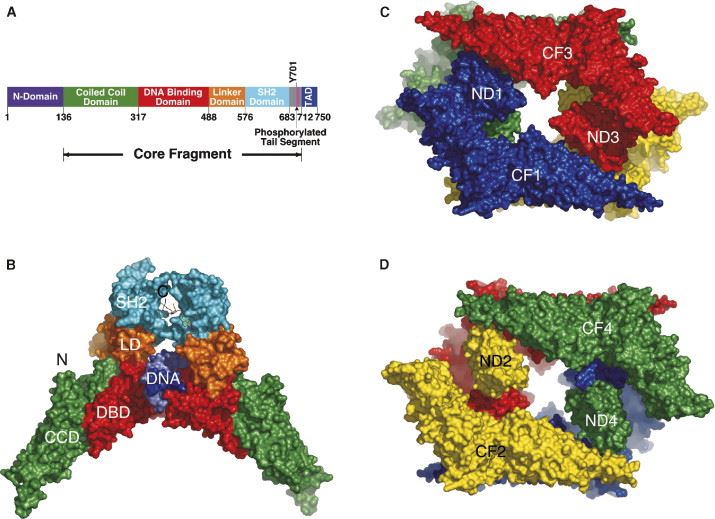What is STAT1 Protein
Signal transducer and activator of transcription 1 (STAT1) is a key protein in cellular signaling, coordinating responses to extracellular signals.
STAT1 is a transcription factor in the JAK-STAT signaling pathway that converts external signals into cellular responses. Structurally, it possesses an N-terminal domain, a coiled-coil domain, a DNA-binding domain, a linker domain, an SH2 domain, and a C-terminal transactivation domain. This modular structure allows for complex molecular interactions that enable STAT1 to transmit signals from the cell membrane to the nucleus.
 Figure 1. Structures of STAT1 (Mao, X., et al. 2005)
Figure 1. Structures of STAT1 (Mao, X., et al. 2005)The Function of STAT1 Protein
STAT1 is centrally involved in regulating immune responses and maintaining cellular homeostasis. External signals, such as interferons, trigger JAKs to phosphorylate STAT1. Once activated, STAT1 forms dimers and translocates to the nucleus, binds to specific DNA sequences and initiates the transcription of target genes. Its major role in antiviral defense, cell growth regulation, and apoptosis emphasizes its importance in cellular function.
STAT1-Related Diseases
Dysregulation of STAT1 activity is associated with a variety of diseases. Mutations in the STAT1 gene cause immunodeficiency disorders, impairing the immune system's ability to fight infections. Conversely, overactivation of STAT1 can lead to autoimmune diseases such as rheumatoid arthritis and lupus because the immune system mistakenly targets healthy tissue. The delicate balance of STAT1 activity is critical for maintaining health.
STAT1 Related Signaling Pathways
JAK-STAT pathway activation begins with ligand binding to cell surface receptors, triggering JAK phosphorylation of STAT1. Phosphorylated STAT1 forms dimers and translocates to the nucleus, regulating gene expression. This highly conserved pathway plays a key role in growth, survival and immune responses. Abnormalities in the JAK-STAT pathway have been implicated in a variety of diseases, emphasizing its importance in cell signaling.
Applications of STAT1 in Biomedical Research
- Cancer Therapy
STAT1's dual role in cancer, acting as both a tumor suppressor and a tumor promoter, provides a nuanced approach to cancer treatment. Enhanced STAT1 activation may induce apoptosis in cancer cells, whereas inhibition of sustained activation may impede tumor progression. Targeting STAT1 provides a personalized and effective strategy for cancer treatment.
- Immunotherapy
Immunotherapy has revolutionized cancer treatment by harnessing the immune system to target cancer cells. Understanding the role of STAT1 in immune regulation provides opportunities to fine-tune immunotherapeutic approaches. Modulating STAT1 activity can enhance immune responses against tumors, paving the way for more effective immunotherapies.
- Infectious Disease
The involvement of STAT1 in antiviral defense makes it a potential therapeutic target for viral infections. Manipulating STAT1 activity can enhance host immune responses, providing a new approach to treating viral infections that pose a major public health challenge.
- Autoimmune Disease Treatment
Dysregulation of the JAK-STAT pathway, including aberrant activation of STAT1, is associated with autoimmune diseases. Targeting STAT1 holds the promise of modulating the overactive immune response in diseases such as rheumatoid arthritis and lupus, allowing for more precise and effective treatments.
The role of STAT1 in cell signaling makes it a promising target for biomedical applications. From cancer therapy to immunomodulation and infectious disease treatment, STAT1's multifaceted functions open the way for innovative and targeted therapies. As research continues, unraveling the complexities of the STAT1 and JAK-STAT pathways promises to lead to breakthroughs that will reshape the medical landscape and usher in a new era of precision and effectiveness.
Recommended Products for STAT1 Protein
| Cat.# | Species | Product name | Source (Host) | Tag |
|---|---|---|---|---|
| STAT1-8473H | Human | Active Recombinant Human STAT1, His-tagged | Sf21 Insect Cell | His |
| STAT1-7037H | Human | Recombinant Human STAT1, His & GST tagged | Insect Cell | His/GST |
| STAT1-2996H | Human | Recombinant Human STAT1 protein, GST-tagged | E.coli | GST |
| STAT1-331H | Human | Recombinant Human STAT1 protein, His/MBP-tagged | E.coli | His/MBP |
| STAT1-2783H | Human | Recombinant Human STAT1, His-tagged | E.coli | His |
| STAT1-2901H | Human | Recombinant Human STAT1 Protein, MYC/DDK-tagged | HEK293 | Myc/DDK |
| Stat1-1733M | Mouse | Recombinant Mouse Stat1 protein, His & T7-tagged | E.coli | His/T7 |
| Stat1-6168M | Mouse | Recombinant Mouse Stat1 Protein, Myc/DDK-tagged | HEK293T | Myc/DDK |
| STAT1-4516R | Rhesus Macaque | Recombinant Rhesus monkey STAT1 Protein, His-tagged | Mammalian Cell | His |
| STAT1-2129C | Chicken | Recombinant Chicken STAT1 | Mammalian Cell | His |
Reference
- Mao, X., et al. Structural bases of unphosphorylated STAT1 association and receptor binding. Mol Cell. 2005, 17(6): 761-71.

